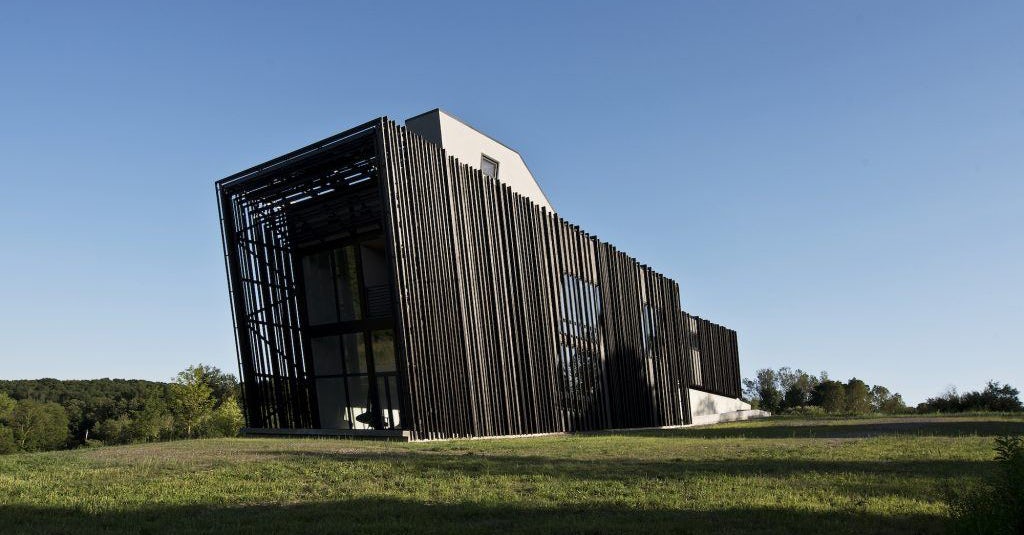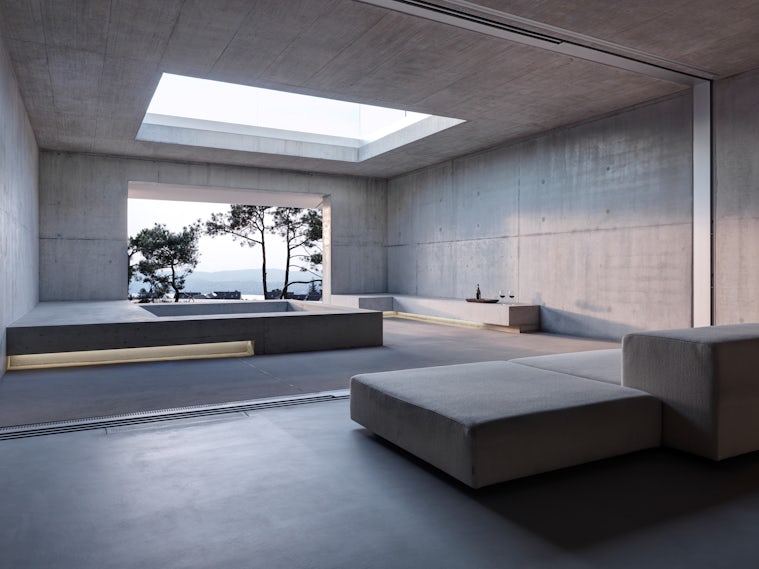The judging process for Architizer's 12th Annual A+Awards is now away. Subscribe to our Awards Newsletter to receive updates about Public Voting, and stay tuned for winners announcements later this spring.
Set atop 15 acres of rolling landscape within New York’s Hudson Valley is a striking, slanted weekend home sporting a charred-wood skin. Weathered in an age-old, Japanese finishing technique called shou sugi ban, the ebony wood cladding and slats that line its boxy façades possess a rough and raw texture, showcasing a formerly countrified style that is boldly making its way into Western architectural practice.


Sleeve House; top via Delta Millworks, bottom via actual / office
Sleeve House, designed by actual / office, is a recently completed 2,500-square-foot building constructed in collaboration with one of America’s pioneering wood manufacturers, Delta Millworks. The Austin-based company leads the country in the ancient tradition of shou sugi ban, offering sustainably sourced, modified wood products to clients all over the world. In the case of this upstate house, the lava rock–like look of Delta’s fire-treated Accoya wood gives the monolithic concrete design a dramatic yet earthy tone. The natural materials evoke the natural setting and the solitude of the space.
The art of shou sugi ban is simple to understand in theory but difficult to carry out. It’s a counterintuitive method of preserving and protecting wood by charring it with fire. This treatment leaves a dense carbonized layer of bituminous black that’s virtually fireproof. Shou sugi ban, called “yakisugi” in Japan, means “burned cedar board” and was widely used in the 18th century on rural homes and rice storehouses that commonly were susceptible to fires. In 2008, Delta Millworks began experimenting with the charring technique and quickly garnered large-scale commercial commissions requesting the product.
“There’s a positive trend in the use of wood for many other construction elements,” Delta’s owner Robbie Davis said. “In terms of strength, fire-resistance, natural beauty, sustainability and overall performance, wood is being lauded more and more as the building-product of the future.”

Inside Delta Millworks’ Austin factory; via Delta Millworks
Delta directly sources their wood from world-renowned, modified wood manufacturer Accoya, which provides plantation-grown, acetylated radiata pine (also known as Accoya) from New Zealand. They also work with Norwegian company Kebony, which offers a rich brown color in their product line that’s ideal for specs similar to Western Red Cedar or Ipe — two types of lumber that, when harvested, harm old growth and tropical forests. Delta Millworks chars and finishes their own products in-house in Austin, taking a handcrafted artistic approach to every piece of wood they treat.

For Sleeve House, the architects originally specified a charred Southern cypress sold by Delta, but the expert manufacturer suggested their new, Accoya sustainably sourced softwood would be a better fit because of its satin finish and long-term durability. Thanks to the acetyl alcohol infused in the wood, it becomes very stable and incapable of moisture absorption. In turn, Accoya wood can live 70 to 80 years. Accoya, the company, even offers a minimum 50-year structural warranty for their product.
As it gracefully ages on Sleeve House, the weathered exterior embodies the presence and texture of the local barns and old farm buildings found throughout the region. “Delta was the only mill in the U.S. able to provide material to the specifications needed for this project,” Adam Dayem of actual / office said. “They were willing to work with us in meeting our unusual requests such as charring all four sides of the material.”


Section drawings via actual / office
In shou sugi ban, the planks of wood traditionally are treated only on their outward faces, meaning only one side features the matte-black coverage. Dayem’s team designed sharp geometries that create distinct inner and outer volumes. These angular planks, which are visible from both the outside and inside of the house, required all sides of the panels to be blackened. This unusual cladding design also made for complex siding details.


According to Delta, because Accoya is an extremely workable material that adapts well to a wide variety of joint and attachment details, the volumetric design of Sleeve House was challenging but not impossible to achieve. Many of Delta’s other dark-hued projects involve a unique set of specs, which range from a long-plank private residence in Vancouver to an award-winning cantilevered lake house in Michigan. One of their most popular exterior siding products, Accoya Gator is said to be the most durable finish on the market. Its reptilian texture, created from an intense shou sugi ban process, is so strong, it held up after two years of exposure testing on the Texas coast.
“We’re committed to changing the negative perceptions of using wood, especially in exterior applications,” Davis said. “Wood and lumber were once viewed as a ‘dirty’ product and a depletion of natural resources; however, we believe wood, in combination with modern clean technologies, will be a building-product that will be used more often in the future.”

Via Delta Millworks
Though Delta has only been selling charred wood options since 2010, the 32-year-old company has learned, through trial and error, how to create well-made, highly-sought-after burnt-wood products. They believe two of the most important factors in working with charred wood are the species selection and the charring process itself. It’s important to maintain consistency in the char, especially on large siding jobs.
Over the last 18 months, Delta has revamped their production with new machines and hired an engineer to redesign their burn line. Demand for their personalized processes has rapidly increased, and they’re even shipping overseas having already exported to eight countries so far.
“The challenges presented with growth and change have allowed us to really understand the nuances of shou sugi ban production,” the team said. “Pioneering new finishes and techniques is what started shou sugi ban and drove us to continue to innovate and expand our processes. We are all about increasing both quality and efficiency, but, at the end of the day, the beauty and uniqueness of these wood products and finishes are really what drives us as a company.”

Via Delta Millworks
Actual / office’s Sleeve House is a clear indication of Delta’s charring consistency on large-scale projects and a showcase of the versatility of their preferred softwood. It’s easy to see why matte-black wood cladding — with its unrivaled texture and tone — is something to consider as a statement-making and sustainable use of already-existing resources. As Davis noted, it’s the concept of totally transforming such a piece of plain wood into an innovative, healthy new product that fuels Delta’s unique passion for burning wood.
Search for Wood Siding Manufacturers
The judging process for Architizer's 12th Annual A+Awards is now away. Subscribe to our Awards Newsletter to receive updates about Public Voting, and stay tuned for winners announcements later this spring.









